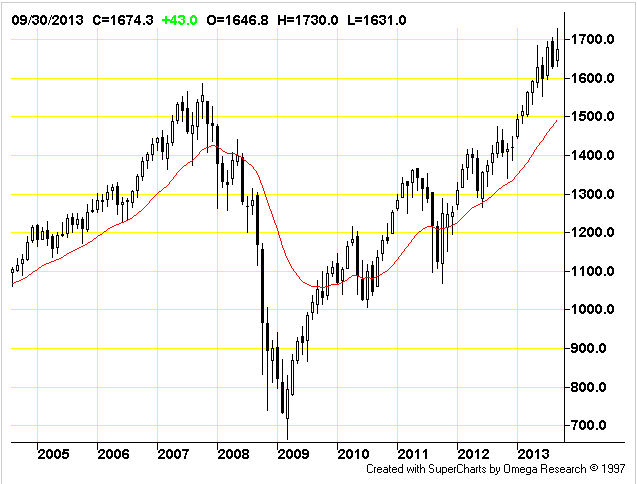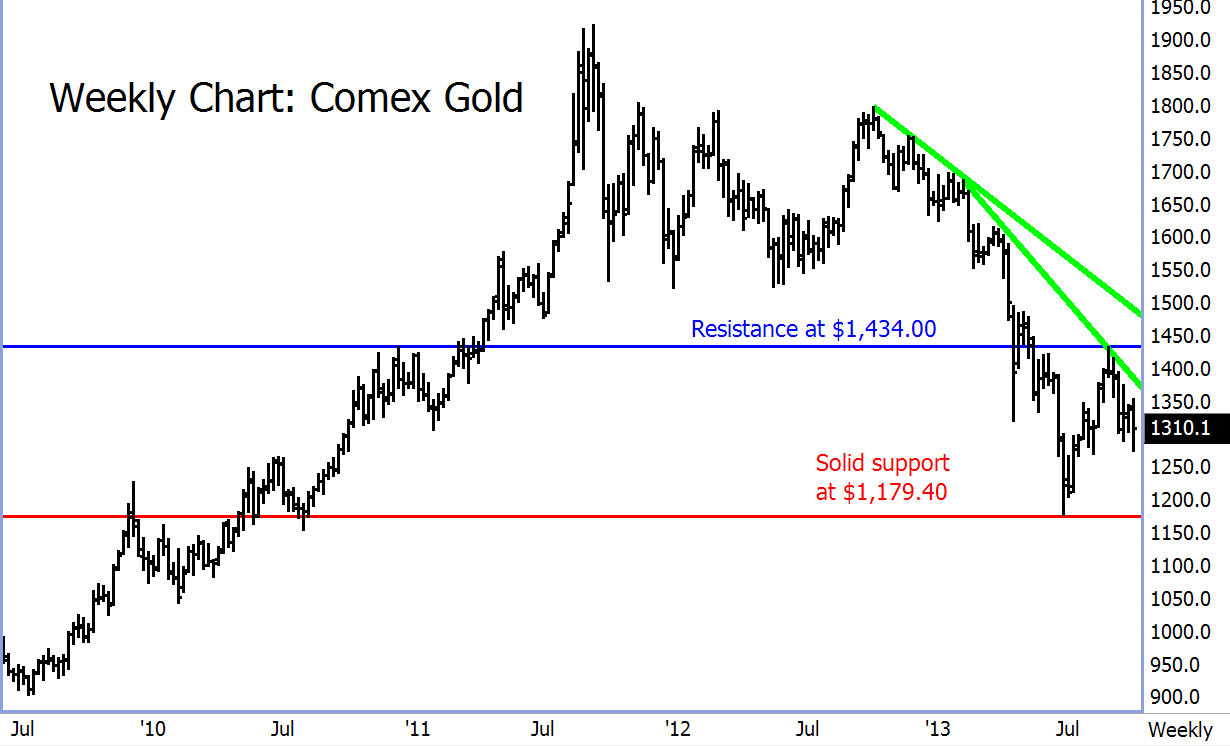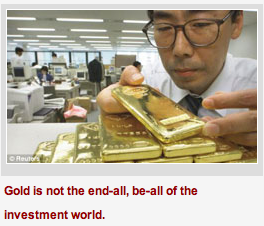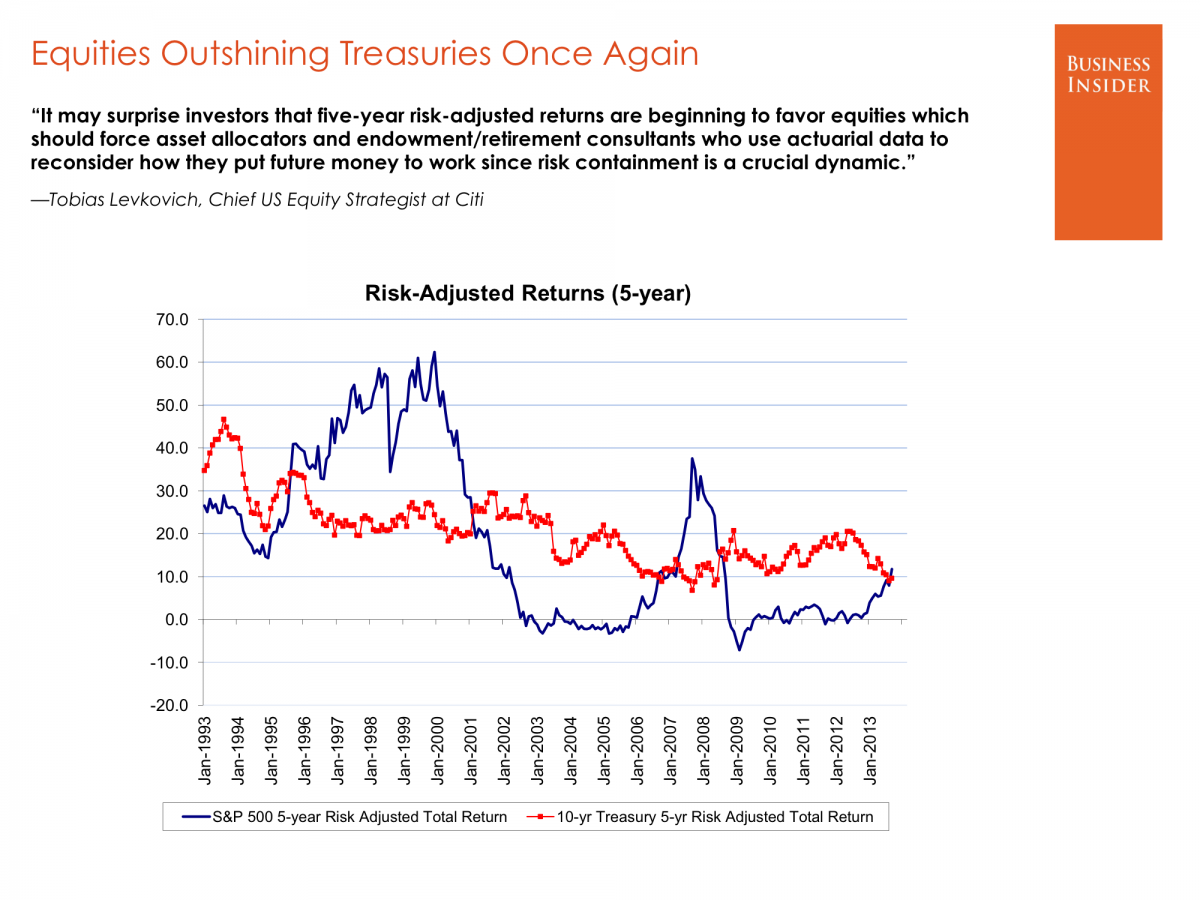Timing & trends
 Every bull market must end at some point and the US market has rallied hard the past year. If you believe the market may have peaked momentarily, you have company in the name of Dr Faber. “We are in a bull market that is in the tail-end instead of the beginning but that does not mean prices will collapse. I don’t think that stocks are the greatest bargain anymore.” (click monthly chart on right for larger view)
Every bull market must end at some point and the US market has rallied hard the past year. If you believe the market may have peaked momentarily, you have company in the name of Dr Faber. “We are in a bull market that is in the tail-end instead of the beginning but that does not mean prices will collapse. I don’t think that stocks are the greatest bargain anymore.” (click monthly chart on right for larger view)
Shares of Casinos in Macau, Iraqi stocks & Physical Gold an Insurance against Mischief
(article source: HERE)
Legendary investor Marc Faber has shares of casinos in Macau interesting buys of Iraqi stocks and sees China’s currency as a serious competitor to the dollar.
Business Week : Mr. Faber, you have to buy gold?
Faber: Yes . Owning physical gold is for me personally an insurance against mischief , driving the governments . In the worst-case scenario …
with state bankruptcies … or hyperinflation …
governments … will not say : Oh, we have made a mistake. You will not find culprit.
And that will be the wealthy ?
I do not think that the individuals’ assets remain untouched.
Gold as an insurance against crises , this is the one . What if I want to speculate ?
As an investor, you can make more money with gold mining stocks . Were virtually destroyed the last price drop and are now favorable to have .
The turnaround in interest rates in the United States has failed , the Fed continues to print money. Is that good for stocks?
The Fed operates in 20 years a policy of monetary expansion . After the collapse of LTCM in 1997 , after the collapse of the Nasdaq and after the real estate crisis, interest rates were kept artificially low – at virtually zero percent today . In March 2009 the U.S. stock index S & P 500 reached its nadir with 670 points. Now we are at 1700 points – a tripling ! The artificially low interest rates and bond purchases have reduced the prices of stocks and real estate driven up . But the economic effect was relatively small . Milton Friedman wrote in ” Capitalism and Freedom “: The problem with government programs , they can always be started due to an emergency , but not abolished , when the emergency is over. Thus, the state is getting more bloated. For the Fed , it is becoming increasingly difficult to end their policy. And if they still do it one day , what will happen to the stock market ?
Which markets are still interesting because for stock investments ?
If you press me 100 million euro in the hand and say that you have to invest in stocks, then I would probably select emerging markets, which has dropped so dramatically lately . Malaysia, Thailand, Hong Kong , Singapore – there are plenty of stocks that have a dividend yield of five percent. That’s not huge, but still signaled that the cash flow of the company is okay. The Vietnamese market is interesting. Japan was not thrilled me, but the Nikkei could run better than other markets .
Sounds underwhelming .
We are in a sideways market. This was back in the seventies when I started my career like that. Nevertheless, there are of course opportunities. Some industries developed tremendously in this sideways market. Did you have gold or energy stocks, you were rich.Marc Faberis an international investor known for his uncanny predictions of the stock market and futures markets around the world.
- Marc Faber : Money left in The Bank loses Purchasi…
- I do not particularly like Chinese Companies . The…
- Responsible Investors Should own Gold
- GOLD is relatively Cheap right now
- Economic Collapse 2013 – Marc Faber Dutch TV Full …
- Faber: Chinese Growth may slow to 4%
- Marc Faber : I started to Invest in Iraqi Stocks …

Here they are: the most important charts in the world.
We asked our favorite portfolio managers, strategists, analysts, and economists across the Street for the charts that they deem the most important right now, and this is what they sent us.
A lot of the focus is on the stock market, as many consider it to be at a critical juncture. The withdrawal of Federal Reserve stimulus and attendant normalization of interest rates is also a hot topic — as is the bloodbath in emerging markets — while many are coming around to the notion that the American economy just can’t grow like it used to anymore.
But there are a lot of other things going on as well.
Click Chart to see a larger view
Ed Note: This is #4 of 103 Great Charts and you can access the first one HERE
Ed Note: This above chart is #4 of 103 Great Charts and you can access the first one HERE


- I’ve been a long-time advocate on Gann Angles. This chart above and commentary expressed (click on this link) is where we stand on gold via Gann. “The Most Important Chart for Gold”
- But thank God there’s no rigging in gold and silver (even those apparently everything else there is).
- Sundown in America
- Text messaging liability – Now a two-way street
I know many readers continue to ask me about two Grandich clients (and personally my two largest holdings) Geologix Explorations and Sunridge Gold. Several have noted how little or no comment has come from someone “paid’ to open his mouth. Hopefully in the not-too-distant future, I will be able to do so.

 Our Quick Pivot of August 22nd noted that the surge in Precious Metals had become speculative. The RSI on the silver/gold ratio had reached 79 when anything above 78 indicated “dangerous conditions”.
Our Quick Pivot of August 22nd noted that the surge in Precious Metals had become speculative. The RSI on the silver/gold ratio had reached 79 when anything above 78 indicated “dangerous conditions”.
The high for the RSI was 80 and the HUI set its high at 283 on August 27 and SSRI reached 10 on the same day. The advice was to take some money off the table and that nimble traders could play the short side of the silver market. Today’s low for the HUI has been 223 and for Silver Standard it’s been 5.95. While the move could generate lower momentum readings, nimble traders could cover shorts.

I love gold. I love its history. I love the role it’s had in many monetary systems. I love the beauty of gold. I love the versatile uses of gold.
I love gold coins. I love objects made of gold. I love gold’s role in new technologies.
But gold is not the end-all, be-all of the investment world. Nor is it the world’s savior. It is not even a very good hedge against inflation.
The hate mail will pour in again. I’m sure of it. But I have my reasons for giving you the truth, and nothing but the truth, about gold. As despised as I’ll be for the facts I give you today, you need to know the truth.
There are all too many myths and propaganda out there about gold, and if you get caught up in them, you most assuredly will lose the shirt off your back investing in gold.
 The fact of the matter is that the chief reason promoted to invest in gold — inflation — is dead wrong.
The fact of the matter is that the chief reason promoted to invest in gold — inflation — is dead wrong.
Consider the following:
 At the depths of the depression in 1929, an ounce of gold sold for $20. The Dow Industrials was at 40.
At the depths of the depression in 1929, an ounce of gold sold for $20. The Dow Industrials was at 40.
An ounce of gold today is roughly $1,300. It has increased 65 times over.
But the Dow Industrials stands at about 15,000. That’s 375 times more than it was in 1929.
And that means since 1930, the Dow has outperformed gold 5.8 times over.
 In 1980, gold sold for $850 an ounce. The Dow Industrials was at 824.6. Since then, gold has increased 1.5 times over, and the Dow 18 times.
In 1980, gold sold for $850 an ounce. The Dow Industrials was at 824.6. Since then, gold has increased 1.5 times over, and the Dow 18 times.
 In 1980, the average price of a single-family home in the U.S. was $68,700.
In 1980, the average price of a single-family home in the U.S. was $68,700.
Today it’s $223,222. It’s increased 3.3 times over (despite the real estate crash five years ago).
Gold’s up just over 50 percent since then.
Now, on the flip side of the coin, since the year 2000, gold’s gained more than 400 percent.
But the Dow Industrials are up a meager 29 percent.
So you see, overall, gold is not as great an inflation hedge as most would like to believe. Certainly not the gold promoters, who want you to buy gold at every twist and turn in the market, forever telling you that it’s the world’s best inflation hedge, when in reality, it is not.
The fact of the matter is this:
First, there are times when gold is a great inflation hedge, and there are times when it is not.
Second, there are times when gold goes up, and there are times when gold goes down, just like any other market or asset class.
Therefore, to maximize your profits in gold, you need to know when to be aggressively in gold, and when not to.
As a corollary, to also maximize your profits, you need to ignore the white noise about gold.
Gold is one of the most emotional markets on the planet, one of the world’s most recognized investments, all over the world.
Yet, it is also the market where the biggest lies are told, the biggest myths are perpetuated, and where the largest amount of misinformation is spread.
I tell you this only because it’s my job to help you protect your wealth. I have no vested interest in doing anything but that.
So bring on the gold investors — and especially the gold dealers and promoters — who will want my scalp for writing this column today. I don’t really give a hoot. All I care about is spreading the historical truth, not BS, propaganda or market myths.
That said, there will soon come a time when it is prudent to load up on gold, but we’re not there yet.
The simple reason is gold’s interim bear market is not yet over.
As you know from my previous columns, I expected a cycle low to form by Oct. 3. We got that low, right on cue at $1,276.90, one day early, on Oct. 2.
But that low did not break the prior low at $1,178. That means the interim bear market is not over yet, and that gold will likely bounce around in a tight trading range for the next few months, then do a swan dive heading into January of next year, where I expect gold will move below $1,178 — and likely bottom around the $1,035 level, or just slightly lower, under $1,000.
And then I will tell you to “back up the truck” on gold. For, you see, during gold’s ensuing new bull market leg higher — it will finally play catch-up with inflation, it will also rise as European and U.S. governments fall from their perches into a heap of rubble — and gold will begin an ascent that will take it to well over $5,000 an ounce.
Timing, in life and in the markets, is everything. Gold is not immune to that law. And it’s just not time for gold to shine again.
If you own gold from much lower levels, as I do and my subscribers do as well, then hold that gold. It’s great insurance. But don’t back up the truck on new purchases yet. Wait until I tell you to do so.
Best wishes, and stay tuned …
Larry
About Larry Edelson
With over three decades of experience in precious metals and natural resource markets, Larry Edelson has played a pivotal role in training Weiss Research staff and in guiding Weiss Research’s customers to prudent investments in these sectors.
His Power Portfolio and Real Wealth Report provide a continuing education on natural resource investments, with recommendations aiming for both profit and risk management. His team of technical analysts helps enhance the timing of investment recommendations with the aim of continually improving performance results for investors.
Mr. Edelson is also an accomplished analyst and writer, making substantial contributions to Weiss Research’s Safe Money Report andUncommon Wisdom.
He holds a B.A. degree from Columbia University. Mr. Edelson got his start on Wall Street in 1978. By 1980, he had his own firm active in international brokerage, financial analysis and money management.
In the mid-1980s, Mr. Edelson was one of the largest gold traders in the world, responsible for as much as $1.4 billion in daily gold trading volume on the Comex in New York, in today’s dollars. Mr. Edelson also managed several multi-million-dollar natural resource and commodity-based private investment funds.
Widely respected throughout the financial industry for his forecasts, Mr. Edelson has successfully called nearly all the major turning points in the world’s macro-economic trends, including …
-
The Stock Market Crash of 1987 and its subsequent rally to new highs by 1990.
-
The 21-year bear market in precious metals.
-
Major turning points in the currency markets, including the now multi-year-long decline in the dollar.
-
The peak of the stock market bubble in 2000.
-
The new bull market in natural resources that began in 2001.
-
One of the only analysts in the world to correctly identify in 2004 the start of the major bull markets in Asian economies and stocks.
Frequently quoted in international press, including Forbes, Bloomberg, CBS MarketWatch and more, Mr. Edelson travels extensively through Asia each year, bringing his followers first-hand analysis and accounts of the vibrant emerging economies.













